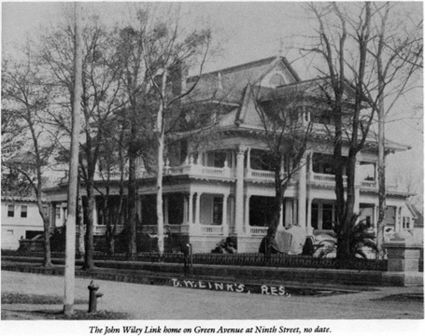Notable Green Avenue mansion fell 50 years ago this month
Last updated 6/10/2008 at Noon
When Green Avenue in Orange was lined with mansions 100 years ago, one stood out among the others, and it wasn’t the Stark House.
The John Wiley Link home was considered larger and more elegant than even the Stark House, which is now a preserved home on the National Register of Historic Places. But time didn’t save that three-story mansion and fifty years ago this month, it was demolished.
People in Orange today still talk about the house and how they wish it could have been preserved. By the time it was torn down, it was owned by First Presbyterian Church. The church had used the mansion for Sunday school classes and classes for the Presbyterian Day School.
The mansion at Green and Ninth was built by John Wiley Link (for whom Link Street is named) in 1903, according to Dr. Howard Williams’s book “Gateway to Texas.” The Lutcher Memorial building of First Presbyterian Church was built next door to the Link home, with construction on the church starting in 1908.
Link had come to Orange in 1896 as a lawyer and began investing in real estate and the timber industry. He soon was a partner in the Miller-Link Lumber Co. and the Yellow Pine Paper Mill in Orange.
The mansion was in the Greek revival style and was known by its marble steps and two-story tall Corinthian columns. Spacious galleries were on the first and second floors, allowing the family and friends to enjoy outdoor breezes.
Hall of Fame baseball manager Branch Rickey, who was in Orange a few years when the St. Louis Cardinals had spring training camp here, praised the mansion. A 1958 newspaper article about the Link mansion quoted Rickey as writing, “I have traveled from Frisco to Boston, from St. Paul to New Orleans. I have seen the showplaces of the idle rich and the industrious rich, many finer and more costly homes I have seen, but no one that I would rather have than this white house in Orange with noble and simple columns, dim cool galleries and the lordly palm trees that guard and deck its marvelous mantle of a lawn.”
Windows in the mansion were of cut glass, even in the servants’ quarters, the newspaper article said. Each of the large bedrooms had a fireplace and its own bathroom, a real luxury in a time when many private homes in town still had outdoor facilities. The sinks and other fixtures in the bathrooms were of pastel porcelain, a rarity at the time.
Link served as mayor of Orange from 1900 to 1903, according to Dr. Williams’s book, and was known for having all the streets in the city graded and paved with shell. He moved to Houston about 1911.
Dr. E.W. Brown Sr. and his wife, Carrie Lutcher Brown, bought the house for their daughter, Mrs. R.A. Moore. Mrs. Moore’s daughter, Babette Odom, was interviewed about the mansion for the 1958 newspaper story. She had moved some of the treasures of the Link house to her house, Ta-Lo, in which her son lives today.
Mr. and Mrs. Moore moved from the Link house to live with Carrie Lutcher Brown after Dr. Brown died in 1917, the newspaper article said. The Browns’ mansion was also on Green Avenue, a block east of the Link mansion. Mrs. Moore died in 1918 during the flu epidemic when her daughter was still young.
Later, Carrie Lutcher Brown moved to the Link mansion. After her death in 1941, the family donated it to First Presbyterian Church. Carrie Lutcher Brown had been one of the founding members of the church in 1878.
Mrs. Odom recalled her mother and father redecorating the house with silk damask for the walls and gold door knobs.
The Moores had the Hasselgren Studios of Chicago custom designed Venetian gold-leaf furniture for the large parlor and the furniture in 1958 was at Mrs. Odom’s estate. She also had a huge Gothic fireplace of sculptured granite that was imported from Italy and a canvas mural of a forest scene her mother had used in the den of the Link mansion.
The newspaper article said the Link mansion was the first house in Orange to have steam heat and a special compartment in the dining room allowed the steam to keep bread warm, which was handy because the kitchen was not close.
Also, the mansion had a glass-domed conservatory between the house and the church. The conservatory was filled with tropical plants and palm trees grew to great heights.
By 1958, though, many of the gilded treasures had been taken out of the mansion and children had lessons in the grand parlors. The once luxurious silk wall coverings had faded and deteriorated. Pink roses painted on ceilings had faded, the newspaper article said.
“Deep layers of dust fill the intricate carving and crevices of the heavy mahogany woodwork, and cobwebs lurk in nooks. Huge chunks of plaster have cracked and dropped from the ceilings, the decorations of which are the work of noted artists,” the newspaper reported.
The story also noted “It has deteriorated so badly that it would take a fortune to restore its original grandeur.”
So the church built a $200,000 education building behind the mansion and the mansion was demolished. It still lives in the memories of the people who saw it, whether from the inside or the outside.















Reader Comments(0)